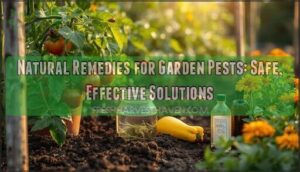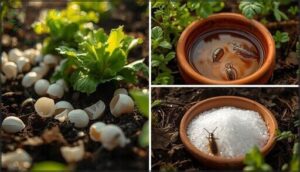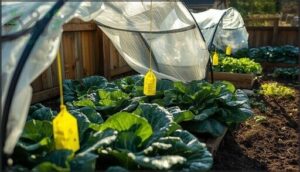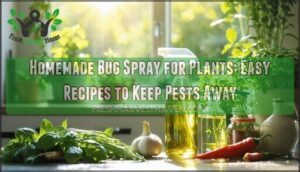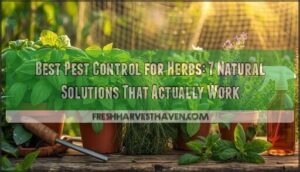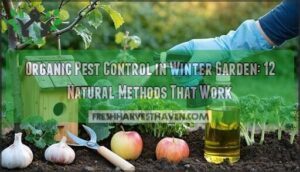This site is supported by our readers. We may earn a commission, at no cost to you, if you purchase through links.
Your tomatoes look healthy one day, then suddenly they’re covered in aphids. Your squash plants wilt overnight from beetle attacks. Chemical pesticides might solve the problem fast, but they also kill the bees pollinating your garden and leave residues on the food you eat.
Natural remedies for garden pests offer a smarter approach. They target the troublemakers without harming beneficial insects or compromising your harvest. From homemade sprays made with ingredients already in your kitchen to strategic planting that turns pests away before they arrive, these methods work with nature instead of against it.
You’ll protect your plants, support a healthier ecosystem, and grow food you actually want to eat.
Table Of Contents
- Key Takeaways
- Preventing Garden Pests Naturally
- Attracting Beneficial Wildlife and Insects
- Companion Planting for Pest Prevention
- Homemade and Natural Pest Remedies
- Safe and Effective Use of Natural Remedies
- Frequently Asked Questions (FAQs)
- How often should natural pest remedies be reapplied?
- Can natural pest control work in large gardens?
- What pests resist most natural control methods?
- How to store homemade pest control solutions?
- When is the best time to apply natural remedies?
- Can coffee grounds repel garden pests effectively?
- Do ultrasonic devices work against garden animals?
- Will vinegar harm plants when spraying pests?
- How often should natural sprays be reapplied?
- Can essential oils replace commercial pest deterrents?
- Conclusion
Key Takeaways
- Healthy soil and proper garden hygiene form your first defense, reducing pest infestations by up to 50%, while pest-resistant plant varieties can cut crop losses by 30-60% before you ever need to spray anything.
- Attracting beneficial wildlife like birds and predatory insects creates a natural defense team that can slash pest populations by 50%, especially when you combine birdbaths, native flowers, and structured habitats like insect hotels.
- Companion planting delivers measurable results—pairing tomatoes with basil reduces pests by 52%, while trap crops like blue hubbard squash can cut insecticide use by 89% in your vegetable garden.
- Homemade remedies like neem oil, garlic spray, and soap solutions effectively control soft-bodied pests when applied every 7-14 days, though you’ll need to time applications carefully to protect beneficial insects and pollinators.
Preventing Garden Pests Naturally
The best defense against garden pests is stopping them before they arrive. You can create conditions that naturally discourage insects and other unwelcome visitors without reaching for a spray bottle.
Let’s look at four proven strategies that form the foundation of a pest-resistant garden.
Building Healthy Soil and Fertility
Building soil fertility is your first line of defense against garden pests. Healthy soil packed with organic matter creates strong plants that naturally resist attacks. When you focus on soil health, you’re setting up a foundation that makes chemical controls unnecessary. Ecological management practices can further improve habitat for plants above and below ground.
- Add compost regularly to increase organic matter from around 21 g/kg to over 23 g/kg through crop rotation
- Balance nutrients carefully since excess nitrogen actually invites more insect damage
- Improve soil structure with organic amendments to reduce compaction and support beneficial microbes that suppress pests naturally
Maintaining Proper Garden Hygiene
Good soil sets the stage, but garden maintenance keeps pests from taking hold. Debris removal reduces infestations by up to 50% during the growing season. Mulch management suppresses weeds that harbor insects. Clear away organic waste and keep pathways tidy.
These IPM sanitation practices form your foundation for preventing garden pest infestations without chemicals. Clean your tools between plants to stop disease spread. Regularly cleaning tools can prevent the spread of plant diseases.
Choosing Pest-Resistant Plant Varieties
Your choice of plant varieties can make or break your natural pest control strategy. Pest-resistant cultivars reduce crop losses by 30–60% compared to susceptible ones. When selecting seeds, look for regional adaptation and genetic resistance bred into the variety.
Crop rotation prevents pest buildup in soil. Smart seed sourcing and cultivar selection mean you’re working with plants that naturally fend off trouble before it starts.
Timing Plantings to Avoid Pests
When you plant can be as important as what you plant. Adjusting your crop calendar to avoid peak pest life cycles cuts infestation by up to 48%. Early sweet corn harvested before mid-July dodges earworm pressure, while late-season faba beans sidestep weevil damage by 18.6%.
Track your planting dates and pest outbreaks—seasonal synchronization is one of organic gardening’s smartest preventative methods.
Attracting Beneficial Wildlife and Insects
You don’t have to fight garden pests alone—nature’s already got your back. Birds, beneficial insects, and pollinators can become your garden’s defense team if you give them a reason to stick around.
Let’s look at three simple ways to roll out the welcome mat for these helpful allies.
Using Birdbaths and Feeders for Pest Control
Birds are your frontline defense against garden invaders—studies show they can slash pest populations by up to 50%. Attracting insectivores like chickadees and warblers gives you powerful biological control without chemicals.
Here’s how to make your garden irresistible:
- Install shallow birdbaths near shrubs for water accessibility and safe perches
- Add feeders with suet or mealworms to boost nesting proximity during breeding season
- Maintain clean water sources using larvicide treatments like Bt to prevent mosquitoes
- Combine with native plantings to support feeding strategies that target aphids and beetles
This natural pest control method delivers measurable results while attracting beneficial insects too.
Planting Flowers to Attract Pollinators
Because over 35% of your food depends on pollinators, flower diversity isn’t optional—it’s essential. Native plantings attract considerably more beneficial insects than exotic varieties, boosting garden health naturally.
Choose high-performers like ‘Music Box Mix’ sunflowers or ‘Envy’ zinnias for continuous seasonal patterns that support natural pest control methods.
This companion planting strategy delivers economic impact while strengthening plant health, and garden adoption is easier than you’d think.
Creating Habitats for Predatory Insects
How do you turn your garden into a magnet for pest-eating allies? Build structured habitats that beneficial insects can’t resist. Insect hotels with drilled wood attract solitary wasps that slash caterpillar numbers by 30%. Beetle banks double ground beetle populations for natural pest control methods.
Mulch benefits include sheltering spiders and predators. Add hedgerow havens with native shrubs, and combine them with companion planting and cover crops to boost plant health while supporting pollinators year-round.
Companion Planting for Pest Prevention
Companion planting is one of the smartest ways to keep pests away without spraying anything. Certain plants naturally repel insects, confuse them, or even lure them away from your prized vegetables.
Let’s look at which combinations work best and why they’re worth adding to your garden plan.
Best Plant Combinations for Repelling Pests
When you pair the right plants together, you create a natural defense system in your garden. Companion planting strategies like tomato & basil reduce pests by 52%, while cabbage & dill cuts cabbageworm populations by 62%.
Squash & nasturtium, lettuce & alyssum, and potatoes & tansy are proven companion planting techniques for pest control that deliver real results without chemicals.
Herbs That Deter Insects
Certain herbs pack a serious punch for keeping pests away. Garlic’s insecticidal action cuts pest populations by 60–80%, while mint’s pest repellency reduces flies and spiders by 65% within three days. Basil mosquito control drops hatch rates by 80%, and lemongrass citronella uses block mosquitoes for two hours. Sage moth deterrent lowers caterpillar damage by 38%.
Using herbs for pest control through companion planting strategies delivers natural pest remedies without harsh chemicals—essential oils work.
Trap Crops and Decoy Plants
Think of trap crops as sacrificial bodyguards for your main plants—they take the hit so your vegetables don’t have to. Perimeter planting of decoy plants like blue hubbard squash slashed pepper insecticide use by 89% in commercial trials while delivering near-perfect fruit.
Here’s what makes trap cropping work:
- Crop allocation: Set aside 5–20% of your garden space for trap plants
- Strategic placement: Border positioning intercepts pests from multiple directions
- Timing matters: Establish decoys before your main crops become vulnerable
- Proven choices: Sorghum for cotton, black mustard for sweet corn
- Ongoing monitoring: Check traps weekly to prevent pest overflow
This companion planting method reduced beetle populations by 95% in controlled studies. IPM impact goes beyond pest control—farms reported profitability gains up to $378 per hectare.
Commercial adoption remains limited, but six cucurbit growers achieved insecticide-free crops using this natural pest control strategy. Plant protection through trap crops preserves beneficial insects while handling garden pests effectively.
Flowers That Protect Vegetables
Marigolds slash nematode populations by 60% around tomatoes and peppers while cutting Mexican bean beetle damage in half. Nasturtiums drop aphid counts 70% on beans and cucumbers—acting as natural trap crops for whiteflies.
Geraniums reduce Japanese beetle infestations 39% near cabbage, and chrysanthemums repel spider mites with 68% effectiveness. Lavender insect barriers cut flying pest problems 61% for lettuce.
These companion planting flowers deliver organic gardening results without harsh chemicals.
Homemade and Natural Pest Remedies
You don’t need to spend money on expensive pest control products when your pantry and garden shed already hold effective solutions. Simple ingredients like soap, oil, and hot peppers can protect your plants from common invaders.
Here are the most reliable homemade remedies that actually work.
Neem Oil, Diatomaceous Earth, and Garden Lime
Three natural pesticides stand out for their proven effectiveness. Neem oil uses include disrupting insect reproduction by up to 90% when you apply it weekly at a 2% concentration.
Diatomaceous earth works as a physical barrier, reducing slug damage by 70%—just remember to reapply after rain.
Garden lime shows mixed results: it cuts flea beetles by 65% but may reduce yields, so use it sparingly.
Soap, Baking Soda, and Vegetable Oil Sprays
You can make effective natural pest remedies right at home. Soap spray knocks out aphids and spider mites by 80% using just 2.5 tablespoons per gallon—reapply every four to seven days. Vegetable oil spray cuts aphid populations by 70% at one-third the cost of chemical options.
Baking soda spray fights powdery mildew, not insects. These homemade remedies target soft-bodied pests while protecting beneficial insects.
Garlic, Hot Pepper, and Chile Sprays
Garlic spray and chile pepper spray pack a surprising punch against soft-bodied pests. Garlic spray cuts cabbage aphid populations by 42% and diamondback moths by 32%. Hot pepper spray reduces aphids by 26%.
When you combine garlic with chile, you’ll see aphid numbers drop by 68% two weeks after application. These homemade pest control solutions work best when you reapply them every seven to fourteen days.
Epsom Salt, Eggshell, and Beer Traps
Kitchen scraps can become your secret weapons against garden invaders. Eggshells create sharp barriers that slice into soft-bodied slugs and snails, while beer traps lure them to their doom. But Epsom salt myths persist—it won’t kill pests despite popular claims.
- Crushed eggshells irritate and dehydrate crawling pests
- Beer traps attract 64 times more slugs than water
- Slugs show no brand preference in lager selection
- Combine remedies for better control of slug populations
Sticky Traps and Physical Barriers
When you’re looking for natural pest control methods that don’t involve sprays, sticky traps and physical barriers offer practical solutions. Yellow sticky traps can cut greenhouse whitefly numbers by up to 50%, though they work better for monitoring data than full pest management. Deploy them 10–12 days before pests emerge for best trap effectiveness.
| Method | Best For |
|---|---|
| Sticky Traps | Monitoring flying pests, greenhouses |
| Row Covers | Blocking beetles, reducing cabbage maggots |
| Barrier Walls | Stopping stink bugs, larger crawling pests |
Physical barriers like insect netting provide season-long protection with minimal environmental impact. Barrier costs average $60–99 per 150 square meters—a worthwhile investment that reduces your need for chemical treatments. You’ll need to maintain covers as plants grow, ensuring they stay attached for effective pest control methods throughout the growing season.
Safe and Effective Use of Natural Remedies
Natural remedies work best when you use them the right way. Timing, application methods, and understanding which plants or insects might be affected all play a role in getting results without causing harm.
Let’s cover the key practices that keep your garden safe while you tackle those pests.
Protecting Beneficial Insects and Pollinators
Natural pest remedies work best when you protect the good guys in your garden. Even eco-friendly pest management can harm beneficial insects and pollinators if you’re not careful. Here’s how to keep your helpers safe:
- Time evening applications when bees and butterflies aren’t active—spray after sunset to avoid direct contact
- Choose least-toxic options like neem or soap sprays instead of broad-spectrum products
- Modify habitat by planting diverse flowers and leaving some undisturbed ground for nesting sites
Label adherence and mindful practices prevent off-target drift to flowering areas.
Avoiding Plant Sensitivity and Damage
Even gentle natural remedies can cause foliar damage if you’re not careful. Plant sensitivity varies widely, so test a small area first. Follow dilution rates closely—neem oil or soap above 3% can burn leaves.
Application timing matters: spray during cooler hours to protect plant health. Watch for early signs like yellowing or browning. Remedy rotation prevents stress buildup while maintaining plant tolerance.
Environmental and Health Benefits
Switching to natural remedies cuts your carbon footprint dramatically—farming studies show pesticide reduction can lower emissions by 70%. You protect soil health and water quality while keeping toxins out of your food.
Natural remedies dramatically reduce your carbon footprint by 70% while protecting soil, water, and food from harmful toxins
Public health benefits add up too: fewer respiratory issues, safer gardens for kids and pets. These environmental benefits of ecofriendly pest management make sustainable gardening practices a win for everyone.
Comparing Natural Vs. Chemical Controls
Chemical pesticides might seem like a quick fix, but pest resistance makes them less effective over time. Natural pest control addresses environmental impact head-on—sustainable farming methods cut pesticide use by 80% while maintaining yields.
You’ll dodge human health risks and long-term costs tied to soil contamination. The environmental benefits and health benefits of natural remedies make them smarter investments for your garden’s future.
Frequently Asked Questions (FAQs)
How often should natural pest remedies be reapplied?
Most natural pest control methods need reapplication every 7 to 14 days. Homemade remedies and natural insecticides break down faster than synthetic options, especially after rain. Severe infestations may require weekly treatments for effectiveness.
Can natural pest control work in large gardens?
Yes, natural pest control methods work effectively in large gardens. Biocontrol efficacy reaches 63% pest reduction in large-scale systems.
Landscape complexity, wildlife integration, and organic gardening techniques deliver resistance mitigation while improving economic outcomes through integrated pest management approaches.
What pests resist most natural control methods?
Like armor on a knight, some pests wear defenses that natural pest remedies can’t penetrate. Resistant beetle larvae, persistent soil pests, resilient piercing insects, adaptive vertebrate pests, and tolerant mollusk species cause ongoing crop damage.
How to store homemade pest control solutions?
Store homemade pest control solutions in glass or HDPE containers between 40°F and 90°F, away from sunlight and moisture.
Label each bottle clearly, keep them locked away from children and pets, and check shelf life regularly.
When is the best time to apply natural remedies?
Timing is everything when you’re managing garden pests. Apply natural pest control methods early morning or late afternoon—when beneficial insects rest and pest life cycles are vulnerable—for the best results across seasonal patterns.
Can coffee grounds repel garden pests effectively?
Coffee grounds show mixed results for garden pests. While caffeine solutions effectively kill slugs and snails, dry spent grounds don’t reliably repel most insects. They’re better composted than used directly for pest control.
Do ultrasonic devices work against garden animals?
Think of ultrasonic devices as invisible fences—promising, but often disappointing.
Field performance shows deer, raccoons, and squirrels adapt quickly.
Regulatory actions cite limited species response and key limitations in repelling animals from gardens effectively.
Will vinegar harm plants when spraying pests?
Yes, vinegar can harm plants when spraying pests. Its phytotoxicity causes leaf burn and wilting, especially on young plants.
Target applications carefully, rinse immediately if overspray occurs, and avoid acid-sensitive species entirely.
How often should natural sprays be reapplied?
Most natural pest control sprays need reapplication every 7–10 days, but rain washes them off immediately.
Neem oil degrades in sunlight within two days, so check plants after storms and reapply as needed.
Can essential oils replace commercial pest deterrents?
Essential oils show promise but won’t fully replace commercial pest deterrents. Formulation stability and non-target effects limit replacement potential.
They work best in IPM integration—offering eco-friendly, nontoxic options alongside other pest-control methods.
Conclusion
An ounce of prevention is worth a pound of cure” rings especially true in the garden. When you combine healthy soil, companion planting, and targeted natural remedies for garden pests, you create a system that protects itself.
Your plants grow stronger. Beneficial insects thrive. And you harvest food without chemical residues or guilt.
Start with one or two methods, observe what works, and build from there. Your garden will reward you.
- https://farmonaut.com/blogs/biological-pest-control-methods-top-7-examples-2025
- https://edis.ifas.ufl.edu/publication/IN197
- https://pmc.ncbi.nlm.nih.gov/articles/PMC7914490/
- https://environmentalfactor.com/natural-pest-control-vs-chemical-pest-control/
- https://attra.ncat.org/publication/companion-planting-resources/

